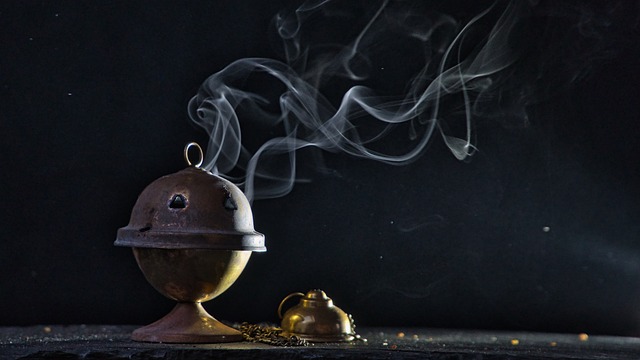A censer, also known as a thurible, is a metal container used in the Catholic Church to burn incense during religious ceremonies. It is typically suspended from chains and swung by a priest or altar server to spread the fragrant smoke throughout the church. The use of incense in Catholic liturgy is symbolic of prayers rising to heaven and purifying the space for worship.
Table of Contents
History of the Censer in Catholic Church
Have you ever been to a Catholic Church and noticed a priest swinging a metal container filled with incense during a religious ceremony? That metal container is called a censer, and it plays an important role in the Catholic Church’s liturgical practices. The use of a censer dates back centuries and has deep roots in religious traditions.
The history of the censer in the Catholic Church can be traced back to ancient times when incense was used in religious ceremonies by various cultures and religions. The burning of incense was believed to purify the air and create a sense of holiness during worship. In the Catholic Church, the use of incense symbolizes the prayers of the faithful rising up to heaven.
The censer itself is a metal container with a chain attached to it, allowing the priest to swing it back and forth during the incensing ritual. The container is filled with incense grains that are ignited to produce fragrant smoke. The swinging motion of the censer is meant to spread the smoke throughout the church, symbolizing the spreading of prayers and blessings to all present.
The use of a censer in the Catholic Church is not only a symbolic gesture but also serves practical purposes. The smoke from the incense is believed to ward off evil spirits and purify the space for worship. It also adds a sense of solemnity and reverence to the liturgical ceremony, creating a sacred atmosphere for prayer and reflection.
Throughout history, the censer has been used in various religious ceremonies, including Mass, processions, and other special occasions. The use of incense in the Catholic Church has been a longstanding tradition that continues to be practiced in many churches around the world.
In addition to its religious significance, the censer also holds cultural and artistic value. Many censers are intricately designed and decorated with symbols and religious motifs, reflecting the rich history and traditions of the Catholic Church. Some censers are made of precious metals and adorned with gemstones, showcasing the craftsmanship and artistry of the artisans who create them.
The censer is not only a tool for worship but also a symbol of the Catholic Church’s commitment to tradition and reverence. Its use in religious ceremonies serves as a reminder of the importance of prayer, devotion, and spiritual connection. The sight and smell of incense burning in a censer can evoke a sense of peace and tranquility, inviting worshippers to enter into a deeper state of prayer and contemplation.
In conclusion, the censer holds a special place in the Catholic Church’s liturgical practices, serving as a symbol of prayer, purification, and reverence. Its use in religious ceremonies dates back centuries and continues to be an integral part of Catholic worship. The censer’s history and significance reflect the deep spiritual traditions of the Church and its commitment to creating a sacred space for worship and prayer. So next time you see a priest swinging a censer during Mass, take a moment to appreciate the beauty and symbolism of this ancient ritual.
Symbolism of the Censer in Catholic Worship
Have you ever attended a Catholic Mass and noticed the priest swinging a metal container filled with incense? This object is called a censer, and it plays a significant role in Catholic worship. The use of incense in religious ceremonies dates back thousands of years and holds deep symbolic meaning in the Catholic Church.
In Catholic tradition, the censer is used to dispense incense during Mass, processions, and other liturgical celebrations. The burning of incense symbolizes the prayers of the faithful rising up to heaven, as the smoke ascends towards the sky. This act of offering incense is a way to honor God and create a sense of reverence and solemnity in the worship space.
The censer itself is typically made of metal and consists of a bowl to hold the burning incense, attached to a chain or rope that allows the priest or altar server to swing it back and forth. The swinging motion of the censer is meant to spread the fragrance of the incense throughout the church, symbolizing the spreading of prayers and blessings to all present.
During Mass, the censer is often used during the Offertory, when the gifts of bread and wine are brought to the altar. The priest will bless the incense and then place it in the censer, which is then swung in a circular motion as a sign of reverence and adoration. The sweet smell of the incense fills the church, creating a sensory experience that enhances the worship experience for the faithful.
In addition to its symbolic significance, the use of incense in Catholic worship also has practical benefits. The smoke from the incense is believed to purify the air and ward off evil spirits, creating a sense of peace and tranquility in the worship space. The fragrance of the incense is also thought to help focus the mind and lift the spirits of those present, creating a sense of sacredness and holiness.
The use of incense in Catholic worship can be traced back to the Old Testament, where it was used in the Temple of Jerusalem as a symbol of prayer and sacrifice. In the New Testament, incense is mentioned in the Book of Revelation as a symbol of the prayers of the saints rising up to God. The use of incense in Catholic worship has been passed down through the centuries as a way to connect with the ancient traditions of the Church and create a sense of continuity with the past.
In conclusion, the censer plays a vital role in Catholic worship as a symbol of prayer, reverence, and adoration. The use of incense in Mass and other liturgical celebrations helps to create a sense of sacredness and holiness, enhancing the worship experience for the faithful. The sweet smell of the incense, the rhythmic swinging of the censer, and the rising smoke all come together to create a sensory experience that engages the mind, body, and spirit in worship. So next time you attend a Catholic Mass, take a moment to appreciate the beauty and symbolism of the censer as it swings back and forth, carrying your prayers up to heaven.
Rituals and Ceremonies involving the Censer

Have you ever attended a Catholic Mass and noticed a priest swinging a metal container filled with incense? That container is called a censer, and it plays a significant role in the rituals and ceremonies of the Catholic Church. The use of incense in religious ceremonies dates back thousands of years and is a symbol of purification and prayer. In the Catholic Church, the censer is used to enhance the worship experience and create a sense of reverence and awe.
During a Catholic Mass, the censer is typically used during the entrance procession, the Gospel procession, the offertory procession, and the recessional. The priest or deacon will swing the censer back and forth, releasing fragrant smoke that symbolizes the prayers of the faithful rising up to heaven. The use of incense is meant to purify the altar and the congregation, as well as to create a sense of sacredness and solemnity.
The censer itself is a metal container with a chain attached to it, allowing the priest or deacon to swing it gently. Inside the censer, charcoal is lit, and incense is sprinkled on top of the charcoal to create the fragrant smoke. The incense used in the Catholic Church is typically a blend of aromatic resins, herbs, and oils that have been blessed by a priest.
The swinging of the censer is a ritual in itself, with specific movements and gestures that have symbolic meanings. As the priest swings the censer, he may make the sign of the cross or bow his head in prayer. The swinging motion is meant to spread the incense throughout the church, symbolizing the spreading of prayers and blessings to all present.
In addition to its use during Mass, the censer is also used in other Catholic ceremonies and rituals. For example, during the sacrament of baptism, the priest may use the censer to bless the water before it is poured over the head of the person being baptized. The fragrant smoke of the incense is believed to purify the water and make it holy.
The censer is also used during funerals and memorial services in the Catholic Church. As the priest swings the censer over the casket or urn, he prays for the soul of the deceased and asks for God’s mercy and forgiveness. The incense is a reminder of the eternal nature of the soul and the hope of resurrection and new life.
Overall, the censer plays a vital role in the rituals and ceremonies of the Catholic Church. It is a symbol of prayer, purification, and reverence, and its use enhances the worship experience for both the clergy and the congregation. The fragrant smoke of the incense creates a sense of sacredness and awe, reminding all present of the presence of God in their midst. So next time you attend a Catholic Mass, pay attention to the swinging censer and let its symbolism deepen your experience of worship.
Different Types of Incense used in the Censer
Have you ever been to a Catholic Church and noticed a priest swinging a metal container filled with smoke during a religious ceremony? That container is called a censer, and it plays an important role in Catholic rituals. The use of incense in religious ceremonies dates back thousands of years and is a common practice in many faith traditions. In the Catholic Church, the censer is used to symbolize purification, prayer, and the presence of the Holy Spirit.
There are different types of incense used in the censer, each with its own unique scent and symbolism. One of the most common types of incense used in the Catholic Church is frankincense. Frankincense has a sweet, woody aroma and is often associated with the presence of God. It is believed to help purify the air and create a sense of reverence during worship. Another popular type of incense used in the censer is myrrh. Myrrh has a warm, earthy scent and is often used to symbolize healing and spiritual renewal.
In addition to frankincense and myrrh, there are several other types of incense that may be used in the censer during Catholic ceremonies. Some churches use a blend of different scents to create a unique fragrance that enhances the worship experience. Sandalwood, rose, and lavender are just a few examples of other types of incense that may be used in the censer.
The use of incense in the censer is deeply rooted in Catholic tradition and symbolism. The smoke that rises from the censer is believed to carry the prayers of the faithful to heaven. It is also a symbol of the presence of the Holy Spirit, who is often represented as a dove in Christian art. The act of swinging the censer during a religious ceremony is meant to create a sense of movement and energy, as well as to spread the fragrance of the incense throughout the church.
The censer itself is often made of metal, such as brass or silver, and is typically adorned with intricate designs and symbols. Some censers are simple and utilitarian, while others are ornate and decorative. The chains that hold the censer are often long and allow the priest to swing the container back and forth as he walks through the church.
In conclusion, the censer is an important symbol in the Catholic Church and is used to enhance the worship experience during religious ceremonies. The use of incense in the censer helps to create a sense of reverence and purification, as well as to symbolize the presence of the Holy Spirit. Different types of incense may be used in the censer, each with its own unique scent and symbolism. Whether simple or ornate, the censer plays a vital role in Catholic rituals and traditions.
Modern Usage of the Censer in Catholic Liturgy
Have you ever attended a Catholic Mass and noticed the priest swinging a metal container filled with incense? That container is called a censer, and it plays a significant role in the liturgical practices of the Catholic Church. In modern Catholic liturgy, the censer is used to symbolize purification, prayer, and reverence.
The use of incense in religious ceremonies dates back to ancient times, where it was believed to ward off evil spirits and purify the air. In the Catholic Church, the censer is used during Mass to symbolize the prayers of the faithful rising up to heaven. As the priest swings the censer, the smoke wafts through the air, creating a sense of reverence and solemnity in the church.
The censer itself is a metal container with a chain attached to it, allowing the priest to swing it back and forth. Inside the censer, charcoal is lit, and incense is sprinkled on top, creating a fragrant smoke when burned. The incense used in the censer is typically a blend of aromatic resins, herbs, and oils, chosen for their symbolic significance and pleasing scent.
During Mass, the censer is typically used at specific points in the liturgy, such as the entrance procession, the Gospel reading, and the Eucharistic prayer. As the priest swings the censer, he may also recite prayers or blessings, further emphasizing the spiritual significance of the ritual.
The use of incense in Catholic liturgy is rooted in the Old Testament, where it was used in the worship of God. In the Book of Exodus, God commands Moses to build a golden altar for burning incense, symbolizing the prayers of the Israelites rising up to heaven. This tradition was carried on in the early Christian Church and continues to this day in the Catholic Church.
In addition to its symbolic significance, the use of incense in Catholic liturgy also serves a practical purpose. The fragrant smoke helps to mask any unpleasant odors in the church, creating a more pleasant environment for worship. It also adds a sense of beauty and mystery to the Mass, enhancing the overall worship experience for the faithful.
Overall, the censer plays a vital role in modern Catholic liturgy, symbolizing purification, prayer, and reverence. Its use during Mass adds a sense of solemnity and beauty to the worship experience, helping to create a sacred space where the faithful can come together to pray and worship. So the next time you attend a Catholic Mass and see the priest swinging the censer, take a moment to appreciate the rich symbolism and tradition behind this ancient ritual.
Conclusion
A censer in the Catholic Church is a vessel used to burn incense during religious ceremonies. It is typically made of metal and has a chain attached to it for swinging. The smoke produced by the burning incense is believed to symbolize prayers rising up to heaven. Censers are commonly used in Mass, processions, and other liturgical celebrations.


